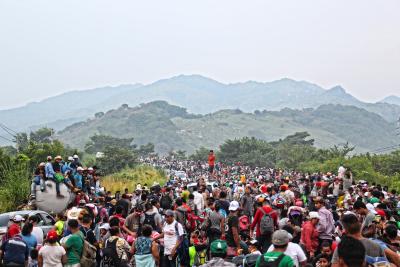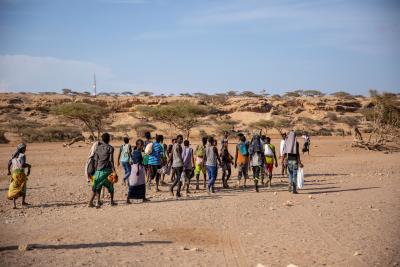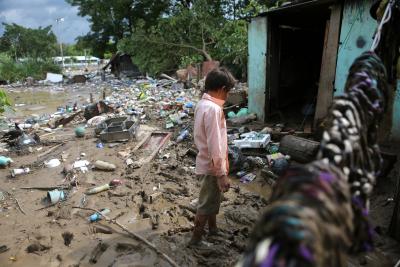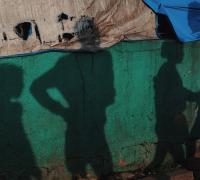Climate change, youth mobility and inequalities: Short-sighted policies are no remedy for climate-related migration

Young adults constitute the bulk of current global migratory movements; half of the world’s refugees are children. Children and young people are the least responsible for devastating climate change impacts; yet, as these impacts intensify, and local livelihoods erode, they bear the brunt of the failure to adapt to future climate change. At the same time, they find their aspirations undermined by successive generations of poverty and inequality.
Since the publication of the 2011 Foresight Report on Migration and Global Environmental Change, climate mobility research has increasingly acknowledged that although environmental change and migration are linked, the links between them are not straightforward. Rather, climate change influences migration in indirect ways, often by affecting already existing social, economic and political inequalities that interfere with people’s capabilities to counteract the negative effects of sudden and slow onset climate disasters. Climate change ranks among the most important dynamics shaping the livelihoods of young people, and hence mobility patterns now and in the future.
Globally, most climate change-related migration is occurring within countries. A high level of vulnerability coupled with demographic pressure nevertheless feeds narratives of future migration flows from vulnerable regions in the global South towards more affluent regions in the global North. In reality, different patterns can be observed regionally. In Central America, for instance, people displaced due to climate change have for some time relocated to neighbouring countries and North America. In Ethiopia, youth migration remains primarily rural-urban but international movements are beginning to rise.
In this article we address the ways climate change and enduring patterns of inequality interact with youth mobility in two regions: Central America (Honduras El Salvador) and East Africa (Ethiopia). We argue that climate change is a youth issue and that failure to take children and youth into consideration in policies directed at addressing climate change and migration will inevitably lead to such policies being ineffective.
Central America
Honduras and El Salvador are small Central American countries with outsized emigration movements mostly directed to the United States. These flows are composed of women, men, and increasingly thousands of youths, the so-called unaccompanied migrant children, who engage in perilous journeys north to escape dire conditions in their home countries. High levels of poverty, multifaceted violence, profound inequalities, and lack of access to dignified wages and social safety nets are key drivers of this migration, exacerbated significantly by various manifestations of climate change (e.g. droughts, hurricanes, landslides, and related insecurity of life). 73.6% of Honduras’ population of 9.5 million live in poverty, while 61.7% of El Salvador’s 6.3 million inhabitants live in poverty. Critically, both countries are at extreme risk of further vulnerability due to environmental disasters. The impact of climate change on El Salvador’s infrastructure has translated into losses of $215 million annually, or about 1% of the country’s GDP (Banco Mundial, 2022). Climate change is a particular threat to Honduras; according to the Global Climate Risk Index, Honduras is in second place among countries with the greatest risk of vulnerability to climate change, with annual losses of 3.3% of its GDP due to climate change (German Watch, 2021). The U.S. government has formally recognized the conditions within the relevant countries and the devastation caused to livelihoods by environmental disasters that these migrants have fled, and has accordingly granted them Temporary Protected Status. Ironically, many of these migrants find jobs cleaning up and rebuilding after environmental disasters in the United States, like Hondurans did after Hurricane Katrina and Venezuelans and other persons in need of protection are doing today.

Ethiopia
With a population of around 123 million (2022), Ethiopia is the second most populous country in Africa (after Nigeria). A high fertility rate translates into a youthful population, large swathes of which end up migrating from impoverished or conflict-ridden rural areas, the majority internally, but increasingly also internationally. Of the latter, around a third have migrated within the last 5 years, the majority aged between 15 and 29 (Central Statistics Agency, 2021). Young Ethiopians aspire to reach the Persian Gulf states and the Middle East, South Africa, and, to a much lesser extent, Europe. More than half travel irregularly, furthering their vulnerability in transit and destination. Gender affects the way migration takes place, the risks faced prior to, during and after migration, and the employment and protection options available. A combination of land scarcity, long-term poverty, and political conflict have magnified the impact of climate change phenomena on already fragile situations. According to UNDP’s Multidimensional Poverty Index, around 42 percent of the population lives in severe multidimensional poverty, an additional 18 percent are classified as vulnerable to multidimensional poverty, and 27 percent lives under the monetary poverty rate (UNDP 2023). Since 2000, the country has suffered nine severe droughts, resulting in famines and severe food insecurity. Young women and girls are particularly vulnerable to violence when collecting water from ever more distant areas. The numbers of child and forced marriages are increasing. The official youth unemployment rate is estimated to reach 23 percent by the end of 2023 and is higher for young women than for men.

Job creation as a remedy
Honduras, El Salvador and Ethiopia are but a few examples of countries in the Global South experiencing similar challenges resulting from the combination of climate change and poverty as well as pre-existing inequalities related to age, gender and social position.
In an attempt to halt irregular migration through employment, as well as attract foreign investment, many of these countries have established Industrial Parks or Free Trade Zones. However, despite the seemingly good intentions, these industrial parks are illustrative examples of the often short-sighted solutions that governments turn to when faced with complex problems related to migration.
In both Ethiopia and Honduras, young women make up 80 percent of the workforce in the industrial parks. Many of these young women/girls come from rural areas or the urban periphery, attracted by the possibility of earning wages to help sustain their families. However, given the nature of the work in these industries - known for low wages and high turnover rates - many young workers soon end up unemployed. With low levels of education and a lack of alternative employment options, these young women become economically vulnerable and at risk of gender-based violence. As such, they most likely join the pool of potential international migrants.
Ironically, most industries operating in these industrial parks - textile, apparel, leather, and plastic production – are known to be among the most contaminating, polluting land and water resources in their vicinity.
In Ethiopia the new Industrial Parks have caused the displacement of nearby farmers. Flower farms, another growing industry, albeit one offering slightly higher wage levels, requires intensive water use, as well as the use of chemical fertilizers and pesticides. Despite environmental protection policies, poor policy implementation and enforcement practices allow both industrial parks and flower farms to discharge their waste improperly or untreated, leading to a decrease in the quality of soil, air and water as well as a reduction in the amount of adequate water available for household consumption and agriculture. This destroys the natural resource base for future generations.
In the short term, the industrial parks provide a quick fix through fast and flexible jobs creation. However, as the jobs are low-pay and the industries create more pollution which further exacerbates the causes of climate change, these kinds of solutions are no panacea for alleviating the structurally rooted problems of inequality, pollution, and climate change in the long term.
Climate mobilities are complex
Turning to the policies of countries receiving migrants, we also see great difficulties in how they deal with the complexities of contemporary migration influenced by climate change.
As climate change generates larger and more multifaceted migratory flows that are sometimes difficult to classify into conventional migration categories at first glance, transit and destination countries enact ever more complex and strict policies of containment. During transit and at entry, individuals forced to mobilize their existence by crossing borders may not immediately identify conditions associated with climate change as their motivation for migration. Such conditions may come in the form of loss of crops, jobs, and dwellings, debts incurred to cover such losses, and deteriorating economic conditions and health, at times due to newly-established industries. From the point of view of the authorities in transit and receiving countries, these individuals become part of the large flows of irregular migrants who do not fit neatly into categories of admission or those laid out in regulations that determine access to protection. As a result, the prevailing rationale in those countries is that these migrants’ mobility therefore needs to be contained.
Containment policies
Policies of containment have generated a formidable array of temporary conditions and legal limbos under which individuals often live for indefinite periods of time. Government policies at exit that create and exacerbate climate change effects, as well as government policies of containment during transit and in destinations, are complicit in creating, facilitating, and exacerbating the vulnerabilities of the individuals most affected by climate change effects. Government policies across exit, transit, and destination are yet another manifestation of the interconnectedness that climate change conditions make visible.
However, here too, key axes of social stratification intersect with policy regulations to create deep inequalities as young people of different genders and social classes interact differently with immigration agencies and have differential access to legal protections and justice systems. For instance, girls and boys leave their homelands with increased frequency as recurrent climate conditions amplify their vulnerabilities but they fare quite differently during transit and at entry, with those who identify as girls enduring specific forms of gender-based violence through smuggling rings and in detention facilities.
Climate Change is a global phenomenon
Climate change has a global impact and as such it connects us all, the Global North and the Global South, in myriad ways, revealing key indicators of our interdependence. Often, the same conditions that propel migration from the Global South (e.g. extreme weather, droughts, hurricanes, floods) create new sectors in the Global North in which people forced to flee find employment (e.g. cleaning up after hurricanes and rebuilding devastated areas). However, climate change does not affect everyone equally, as global inequalities are manifested in the lopsided distribution of climate change effects. For instance, although the Global North contributes disproportionately to depleting the ozone layer, the Global South suffers the consequences in amplified fashion given prior structural conditions (largely caused by the Global North). But inequalities do not only surface at the global level, as manifestations of climate change will also reflect local inequalities along axes of social stratification such as gender, age, race/ethnicity, among others.

Climate change reveals global inequalities but also interconnectedness, providing an opportunity to reframe responsibilities and collaborations. Development strategies targeted at creating light manufacturing jobs for the growing unemployed youth population do little to provide decent, secure, and justly salaried jobs that can compete with potential earnings abroad. They may even further exacerbate the environmental degradation behind migration and thus destroy the livelihood base for generations to come. Future development cooperation should take such paradoxes into account.
Authors
Cecília Menjívar, Professor of Sociology, menjivar@soc.ucla.edu, University of California Los Angeles
Ninna Nyberg Sørensen, Senior Researcher, nns@diis.dk, Danish Institute for International Studies
The opinion article is the outcome of Cecilia Menjívar’s guest professor visit to DIIS under the auspices of the FFU-funded PATHWAYS research programme. Her stay was co-funded by the Fulbright Specialist Program and DIIS’ Climate Initiative.
Sources/Further Reading
Banco Mundial (2022). Banco Mundial Blogs. ¿Cómo no perder US$ 215 millones al año y aprovechar el potencial de los bosques salvadoreños?
Banco Mundial (2023). Industria y agricultora, valor agregado (% del PIB). https://datos.bancomundial.org/indicador/NV.IND.TOTL.ZS?locations=HN
Barómetro de las Américas. Base de datos. Available: https://centro.observatoriorh.org/barometro-de-las-americas
BID/CEPAL (2021). Evaluación de los efectos e impactos de la tormenta tropical Eta y el huracán Iota en Honduras. https://repositorio.cepal.org/bitstream/handle/11362/46853/3/S2100044_es.pdf
Central Statistics Agency (CSA), Ethiopia. 2021. Labour Force and migration Survey Key Findings.
German Watch (2021). Global Climate Risk Index 2021. Who suffers most from extreme weather events? Weather related loss events in 2019 and 2000 to 2019. Bonn, Germany: https://www.germanwatch.org/en
Menjívar, C. 2022. State Categories, Bureaucracies of Displacement, and Possibilities from the Margins. American Sociological Review, 88 (1): 1-23.
UNDP (2023). Multidimensional Poverty Index. Ethiopia: https://hdr.undp.org/sites/default/files/Country-Profiles/MPI/ETH.pdf
DIIS Experts


